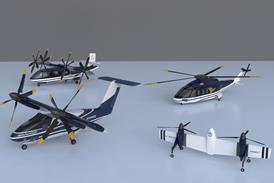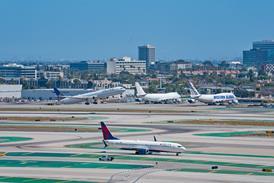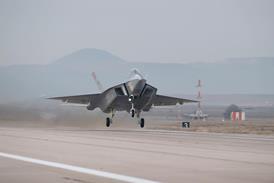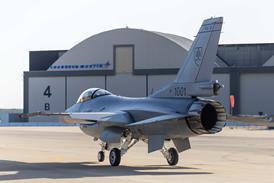Despite the advent of synthetic environments and advanced flight controls, the world still needs test pilots
Paul Lewis/NAS PATUXENT RIVER Julian Moxon/ISTRES Guy Norris/EDWARDS AFB Stewart Penney/DERA BOSCOMBE DOWN
In the more than half a century of test pilot training, methodology has evolved and concepts such as risk management procedures have been incorporated. What is remarkable, however, is how little the training itself has changed.
Four military test pilot schools in France, the UK and the USA train the majority of the world's test pilots. Although most are trained for an air arm, many go on to work as civilian test pilots.
The oldest school is the Empire Test Pilots School (ETPS) at Boscombe Down in the UK, formed during the Second World War. The others are: EPNER (Ecole du Personnel Navigant d'Essais et de Réception) at Istres, France; the US Air Force Test Pilots School (USAFTPS) at Edwards AFB; and the US Navy Test Pilots School (USNTPS) at NAS Patuxent River. A course lasts just under a year and each school trains pilots from numerous other countries. In France and the UK the schools are co-located with the national test centre, while the USAF and USN schools are co-located with the service test centres.
Evidence of long-term teaching trends is no further away than the USNTPS ramp - some of the aircraft in use today at Patuxent River have been used since it started; for example, the de Havilland Canada DHC-2/U-6 Beaver or North American Texan. USNTPS commanding officer, Cdr Bob Stoney, says of the teaching "in many ways it is still the same". The same applies to the other schools.
Test flying is about team work and part of the role of a test pilots' school is to train test pilots and flight test engineers to operate together and develop an understanding of each other's world, says Wg Cdr Dave Best, ETPS officer commanding (OC). He adds: "It's about training interpreters who can talk to operational pilots and designers."
Working together
EPNER director Lt Col Stephane Pichené says the school insists that student pilots and flight test engineers work together to perform tests and analyse the results. "We want them to develop initiatives and capabilities on their own," says Pichené. "We give them the basic test techniques and see what they discover as a team. Then we match their findings with reality during the debriefing and discuss where they might have been wrong."
Best says that increasingly, it is "an ever greater challenge" to put a pilot into the cockpit, and to get right that cockpit, the man-machine interface (MMI) and sensor fusion. "As technology develops, the gulf between the frontline pilot and designer gets wider and we need the test pilot to bridge the gap," he says.
The USNTPS's raison d'être is not to teach pilots, navigators and engineers to fly but rather to train them how to test aircraft, whether it be a glider or the latest fighter. Says Stoney: "In some ways I could still put out a good product by having them train on Cadillacs or toasters."
"One of the things we're teaching is approach - a mindset of how to successfully approach something, assess the risk and carefully implement risk management procedures, conduct the test and then go and report on it," he adds.
The USAFTPS is focusing on a specific vision. It models itself as the national centre of applied aeronautical engineering, as well as a nurturing ground for the USAF's technological leaders. "The USAF worships at the altar of technology," says USAFTPS commandant, Col Steve Cameron, adding that "around three or four of the 40 general officers selected this year were TPS graduates." The school's goal is to be seen, both nationally and internationally, as the testing ground and the practical applied engineering version of centres of aeronautical engineering theory excellence such as the Massachusetts Institute of Technology (MIT).
"This is the only school that requires an engineering degree - usually aeronautics or electrical engineering," says Cameron, who adds that the stipulation forms a cornerstone of the USAFTPS's overall approach to bridging the gap between 'seat of the pants' type test piloting and precise aeronautical engineering. "We bring in people from the Air Force Academy, Air Force Institute of Technology and MIT to teach, so it helps if students already speak their language; for example, when they can both talk about things like stick force per g, rather than 'it feels a bit sluggish'," Cameron says.
The USAF school's ultimate goal is to produce graduates that can "meet any challenge presented by an aerospace vehicle in flight", says Cameron. Graduates must have keen observational powers to report properly on aircraft and systems behaviour, performance and data quality. They must have a strong theoretical understanding of longitudinal and lateral statics and dynamics, propulsion and performance as well as be able to plan, supply and execute any test mission. Crucially, they must be able to apply emerging technologies to future air and space vehicles and their systems. The school, which also teaches flight engineers and navigators insists that its fighter and multi-engine graduates possess the basic flying skills to confidently and precisely fly all types of aircraft under any test condition.
As ETPS' Best notes, aircraft do not emerge straight from the design office as perfect creations. Even the advent of fly-by-wire systems does not guarantee an aircraft will be right the first time. While equations can be derived for a simple system, fly-by-wire and the aircraft as a whole are complex. Therefore, he says, "there is a lot of trial and error, and the test pilot needs to have an input into the design at an early stage." Acquisition reform in the UK has been a positive move as the creation of integrated project teams combining the gamut of stakeholders means that test pilots become involved at the earliest stages.
Increasing emphasis
Gp Capt Keith Denniston, chief test pilot at Aircraft Test & Evaluation at Boscombe Down, says increasing emphasis is placed on involving test pilots at the earliest concept stages of development.
ETPS is part of the Defence Evaluation & Research Agency (DERA), which means it operates on commercial practices but also has access to "some of the world's foremost research facilities and technologies," says Best. The latter is used to broaden the neophyte test pilot's knowledge and understanding. Students fly sorties in the VAAC (Vectored-thrust Aircraft Advanced-flight Control) Harrier and have access to the development flight simulators at DERA Bedford. The VAAC Harrier gives students flying experience with state-of-the art flight controls and flight control systems. Recent VAAC Harrier work has been supporting Joint Strike Fighter (JSF) development. Denniston says flying the VAAC Harrier is a valuable exercise as it looks at high order flight controls and a "radically different way of controlling an aircraft".
Denniston says ETPS is doing "an excellent job in changing the way it does business and the way the course content is continuing changing." Clearly, he says, there is an increasing requirement for test personnel to understand integrated systems, and systems of systems. "These are challenges the world over, and they frequently don't respond to traditional test methods." He adds that at the same time, however, there is still a need for all the traditional flying skills. There is, he says, wide acknowledgement that new subjects should be taught, but there is little agreement on what can be dropped.
Stoney agrees, adding the need to retain basic test pilot training such as flying qualities and performance testing - while adding new course work like integrated systems testing - makes it difficult for the school to keep its syllabus to just 11 months. "It quickly reaches the point where you have 10lb of stuff in a 5lb bag. The challenge is to now and then throw something out and bring in something new. It's constantly changing and improving, but it's something we're very cognisant of because the students are already at capacity," says Stoney.
To ensure USNTPS' syllabus stays relevant to the fleet's needs, feedback is provided by pilots 1.5 years after graduation and by programme leadership every 3-4 years. This ensures that training continues to change and evolve, and has resulted in many additions to the school teaching tools.
All the schools end the course with test flights of a type never previously flown by the student. The USNTPS, for example, lists a healthy choice of aircraft to assign its students for their critical end-of-course report, including the Sukhoi Su-27 Flanker, Shin Meiwa US-1A, Aermacchi/Embraer AMX, UK, Italian and German Panavia Tornadoes, Saab Gripen and USAF Rockwell B-1B and Boeing F-15.
Graduation reports
"They fly the aircraft for a week, they come back and have two weeks to write a 200-page report. Think of it like a master's level thesis. We depend on our international partners, as well as the army, navy and USAF to provide us with these aircraft," says Stoney.
The USAFTPS course also includes test management projects (TMP). TMPs are real test projects with students evaluating new aircraft or systems, as well as troubleshooting problems with current or proposed acquisitions. Recent examples include evaluations of a Swiss-made anti-g suit and of a runaway trim problem on the Boeing KC-135.
The schools work together, exchanging students and instructors and sharing aircraft. ETPS trainees, for instance, use EPNER's Alpha Jet and the USNTPS sends its Lockheed Martin NP-3D Orion systems trainer to Boscombe Down every year for two weeks. Denniston predicts that there will be an increasing trend of sharing aircraft, as any school will be "hard-pressed to provide all the necessary facilities".
The USNTPS NP-3D is equipped as a flying laboratory for integrated systems testing. Systems include a Northrop Grumman APG-66(V2) multimode radar, forward-looking infrared sensor and a digital moving map. The aircraft will evolve with the fusing of simulated off-board data as the USN moves into network centric warfare.
For instance, in the longer term, the USAFTPS is working with the US Navy equivalent and the ETPS on a joint statement of work for a replacement systems aircraft which all could use. "By March we should have a clearer idea of the joint specification," says Cameron.
Joint work among test pilot schools is increasing, comments Cameron. "We have all worked together a lot more than I ever imagined. I am amazed at the spirit of co-operation and how it makes things happen." As well as joint work to help define a common systems aircraft like the Learjet, the USAFTPS is working with the USNTPS on a combined upgrade to the T-38s as well as to develop the T-2 for spinning work.
The USAF school is supporting the continued use of a Northrop Grumman APG-66 radar on the USNTPS's Lockheed NP-3 systems test aircraft. "The air force wants it back, and we're trying to make sure it stays on the P-3," says Cameron. He adds: "We share things like budget information with the navy that I would never have thought possible."
Over the years the USNTPS has fended off periodic calls for the navy to either combine its school with that of the USAF at Edwards or outsource it to a private concern such as the National Test Pilots School. Concern over capacity has so far made the former idea a non- starter. "It only makes sense to combine the two when the throughput is half of what it is today," says Stoney.
USAFTPS's Cameron also rejects any suggestions of a future merger. "What drives things in the US is competition, and if you've got something or someone to benchmark against then it stops you from going stagnant. If you were training for a track event, you'd want to run with someone who was your equal. We have the ideal sort of relationship - it's competitive, but I would never expect to wake up with a knife in my back," he adds.
Boscombe Down's Denniston says that when recruiting students, test pilot candidates must have demonstrated experience from their previous service life as well as have competence to test. "One criteria in selecting test pilots is that they are respected pilots in their fields. Pilots come to Boscombe Down as representatives of the force and they will be influential in clearing new aircraft." It is important, he continues, that test pilots remain credible once trained.
Back to the frontline
Denniston sends test pilots back to the frontline to refresh their knowledge. In recent times, two Fast Jet Test Squadron pilots flew with their previous units during a Maple Flag exercise. And during last year's Operation Allied Force, a Harrier test pilot went back to a squadron and flew operational missions. This, Denniston believes, "can only be beneficial to the quality of testing."
Says EPNER director Lt Col Stephane Pichené: "We're not looking for 'super pilots' ". The aim is to teach them what to observe and how to behave like the "average" pilots that will eventually fly the aircraft. "A test pilot must be able to place the aircraft exactly at a performance point and then hold it there while measurements are taken," says EPNER deputy director Jacques Dumoulin. "He must also observe what is happening around a set condition, looking for unexpected phenomena."
Pichené says "pilots and flight test engineers must be able to assess the aircraft as a whole".
"While we want to familiarise them with modern aircraft and their systems, our main goal is to teach the basic test techniques to use on any aircraft or system. You can't train all students for all of the aircraft they will fly in their career, but assessment of a cockpit is the same whether it is on a Mirage III or a Joint Strike Fighter. There will always be something someone has not thought about."
Students carry out their analysis immediately after each flight using a PC-based flight data processing and analysis system developed by EPNER. Its instrumented aircraft are equipped with a flight data recorder which places all flight data onto a PCMCIA card that can be inserted directly into a PC or stored on a CD-ROM. This allows students to manipulate the different factors that make up a particular performance parameter - engine thrust, for example - so that they become familiar with the behaviour, and potential irregularity of a system of sensors when analysing an aircraft's performance.
EPNER has also developed a unique system which displays the flight parameters in analogue and digital format, and which displays a virtual image of the aircraft's flight path along with a simulated view out of the cockpit window. Students can plug in their PCMCIA cards and observe what the aircraft is doing as it enters, for example, unstable flight leading to loss of control. Coupling this with the situation awareness display will provide qualitative improvements to the tool, says Pichené. So far, only the parameters of the Alpha Jet have been fed into the system, but other aircraft will follow.
Pichené says the forthcoming Airbus A340-500/600 flight test programmes "will definitely reveal aerodynamic problems. It is impossible to predict everything and these are very long aircraft which will almost certainly need modification as a result of flight testing".
Pichené sums up the modern test pilots' school role in an age of computer-based flight control: "The main principles do not change. You still have to assess the system and the way we teach assessment has not changed fundamentally. You have to know the physical phenomenon, even when it is hidden by computers. You know to expect certain phenomena, such as flutter, in certain conditions. We try and show students as many new systems as possible to familiarise them with what they might find in working life."
Source: Flight International























